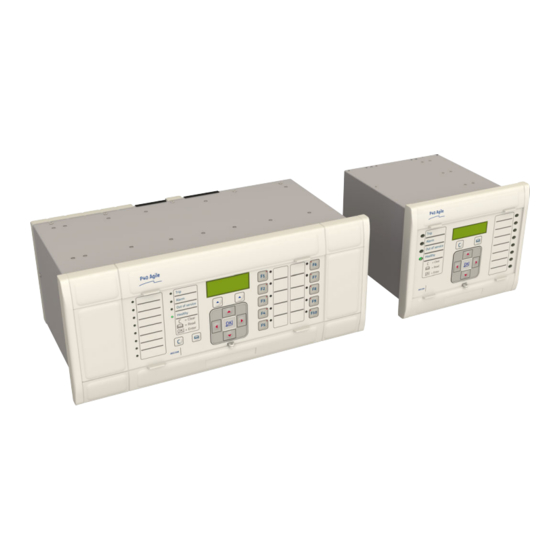
User Manuals: GE P4A Motor Protection Relay
Manuals and User Guides for GE P4A Motor Protection Relay. We have 1 GE P4A Motor Protection Relay manual available for free PDF download: Technical Manual
GE P4A Technical Manual (850 pages)
MiCOM P40 Agile Single Br
eaker Multi-End Current Differential IED (Non Distance)
Table of Contents
-
Foreword
30-
Cip30
-
Nomenclature31
-
Compliance31
-
Cip31
-
-
Cip32
-
Symbols
43 -
Front Panel
61 -
Rear Panel
65 -
-
Pcbs67
-
Watchdog71
-
Input Board76
-
IRIG-B Board78
-
-
-
Interfaces94
-
-
Chapter Overview
101 -
-
Getting Started104
-
Default Display105
-
Password Entry107
-
Menu Structure108
-
Control Inputs110
-
Function Keys111
-
Line Parameters
113 -
Chapter Overview
123 -
-
Basic Algorithm128
-
CT Saturation
135 -
CT Compensation
138 -
-
Feeder Topology142
-
Chapter Overview
151 -
-
-
Logic Modules
173-
Sequence Counter183
-
Reclaim Time189
-
Pole Discrepancy198
-
Chapter Overview
209 -
-
Chapter Overview
221 -
-
NPSOC Logic226
-
-
IDG Curve228
-
-
EPATR B Curve233
-
-
Chapter Overview
249 -
-
Chapter Overview
263 -
-
Chapter Overview
271 -
Event Records
272-
Event Types272
-
Contact Events273
-
Alarm Events273
-
Security Events275
-
Platform Events275
-
-
Measurements
277-
Fault Locator277
-
-
CB Trip Counter279
-
-
CB Healthy Check290
-
System Checks
293-
VT Connections293
-
System Check PSL298
-
Chapter Overview
303 -
-
-
Resistor Values319
-
Chapter Overview
325 -
Scheme Logic
327 -
Function Keys
334 -
Control Inputs
335 -
Chapter Overview
339 -
-
IM64 Logic
349 -
Chapter Overview
357 -
Introduction
358 -
-
Direct Tripping359
-
-
Implementation
360 -
Configuration
361 -
Chapter Overview
369 -
-
End of Session391
-
End of Session394
-
Switch Manager394
-
Installation395
-
Setup396
-
Network Setup396
-
Bandwidth Used396
-
Reset Counters396
-
Ports On/Off397
-
Vlan397
-
End of Session397
-
Data Protocols
405-
Courier405
-
Courier Database406
-
Setting Changes406
-
Event Extraction406
-
Iec 60870-5-103410
-
Initialisation411
-
Commands411
-
Test Mode412
-
Dnp413
-
Iec 61850425
-
-
Read Only Mode
434 -
-
Sntp437
-
PTP Domains438
-
Overview
441 -
Standards
443-
NERC Compliance443
-
Cip 002444
-
Cip 007445
-
Ieee 1686-2007445
-
-
-
Blank Passwords449
-
Password Rules449
-
Logging out456
-
Chapter Overview
459 -
-
Terminal Blocks464
-
RS232 Connection467
-
-
Case Dimensions
468 -
Chapter Overview
473 -
-
Test Mode Cell476
-
Test Leds Cell476
-
Static Test Mode477
-
Loopback Mode477
-
IM64 Test Mode478
-
Product Checks
481-
Insulation482
-
External Wiring482
-
Power Supply483
-
Test LCD484
-
Date and Time484
-
Test Leds485
-
Test Trip LED485
-
Test Opto-Inputs485
-
Setting Checks
494 -
-
Testing Examples497
-
Contact Test500
-
Onload Checks
510 -
Final Checks
512 -
Chapter Overview
515 -
Maintenance
516-
Alarms516
-
Opto-Isolators516
-
Output Relays516
-
Replacing Pcbs519
-
Recalibration522
-
Battery Disposal523
-
Cleaning523
-
Troubleshooting
524-
Power-Up Errors524
-
Backup Battery526
-
Incompatible IED527
-
Comms Changed527
-
IEEE C37.94 Fail528
-
Chapter Overview
533 -
Interfaces
534-
Rear Serial Port534
-
PPS Port537
-
-
-
General544
-
Fault Locator544
-
-
Ratings
545 -
Type Tests
551 -
-
Power Frequency555
Advertisement
Advertisement
